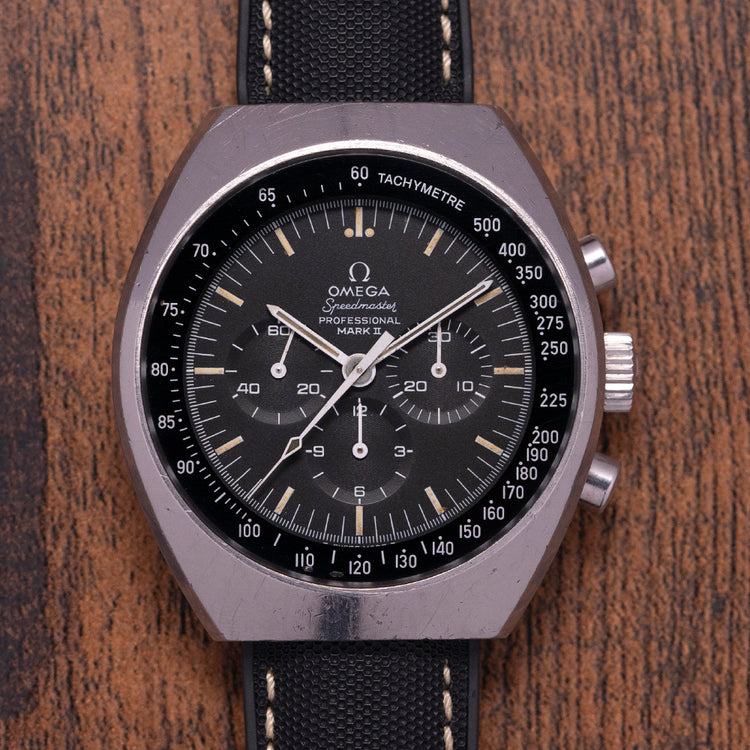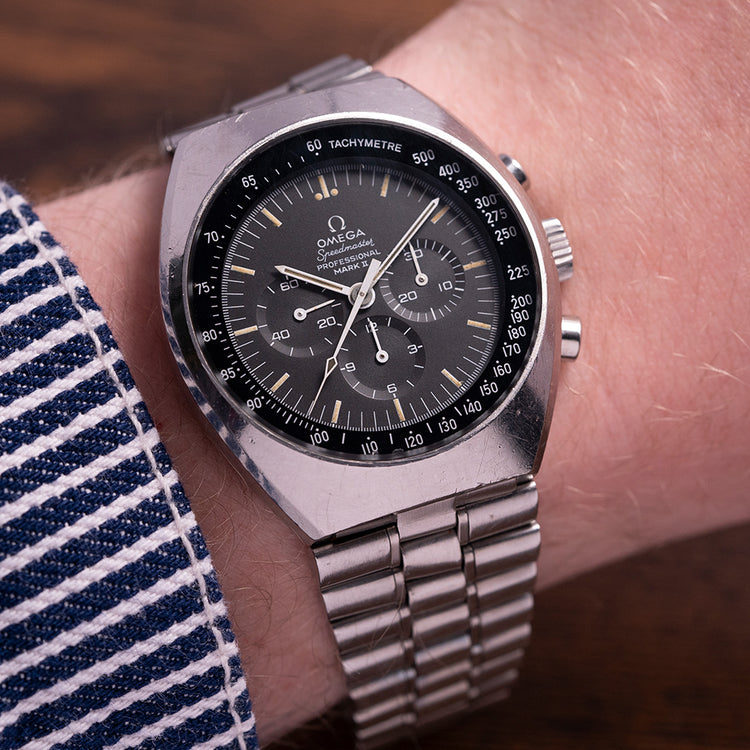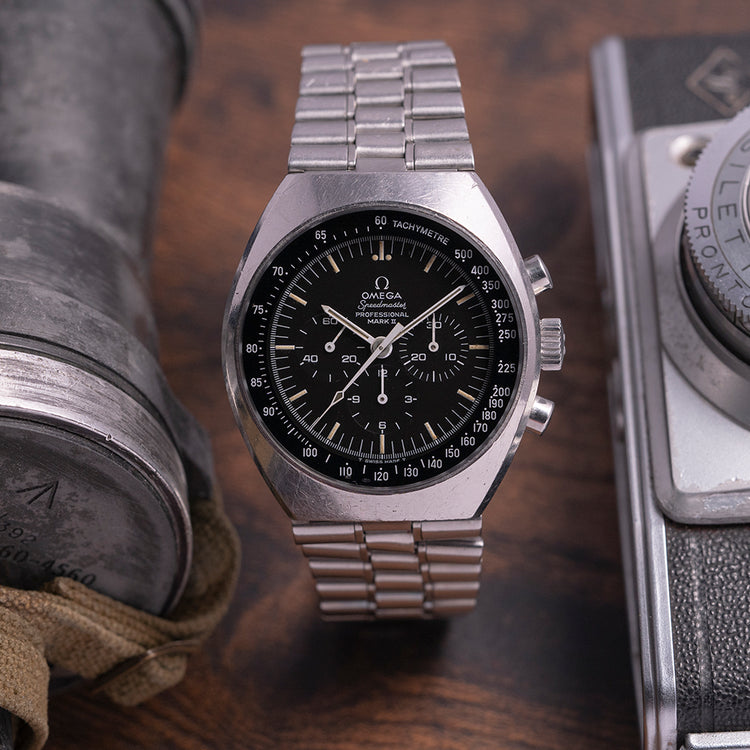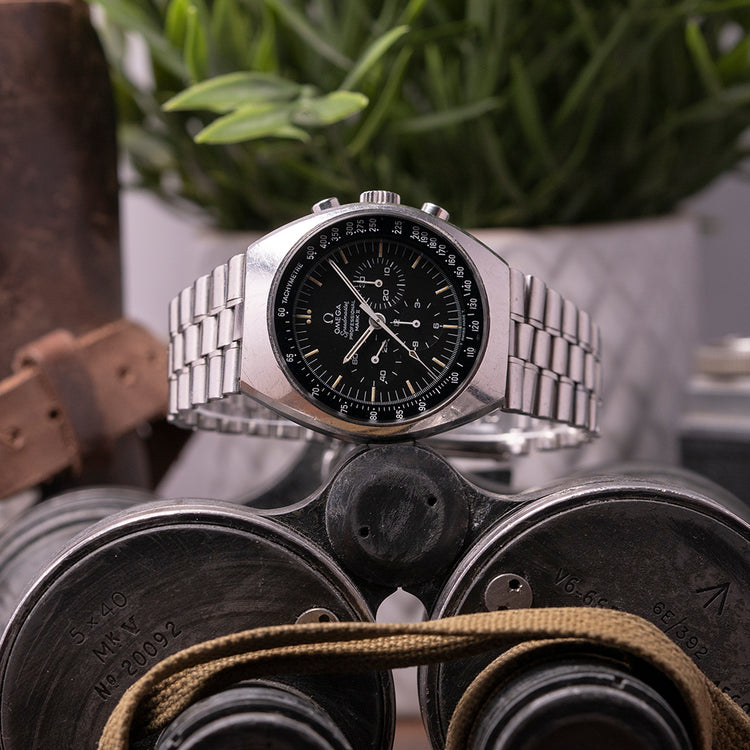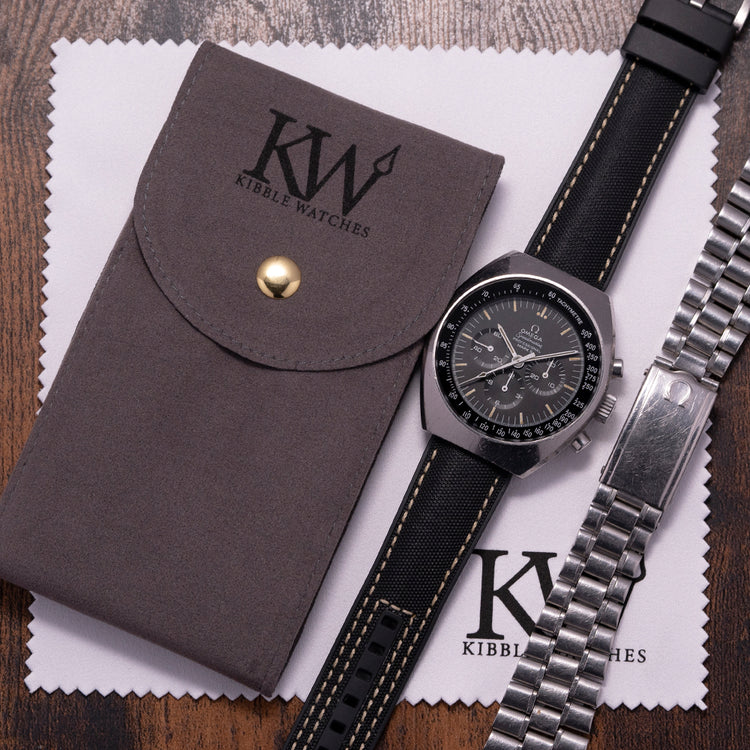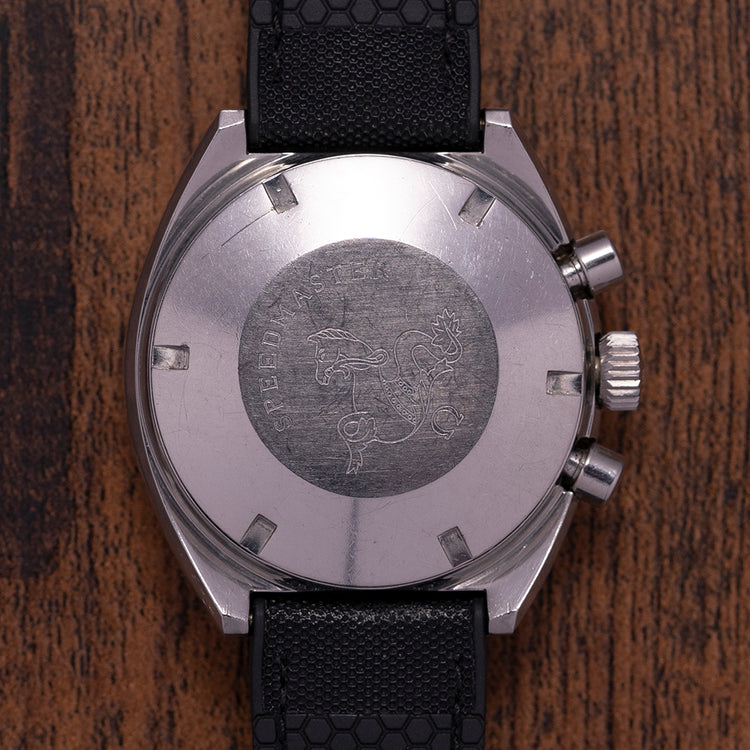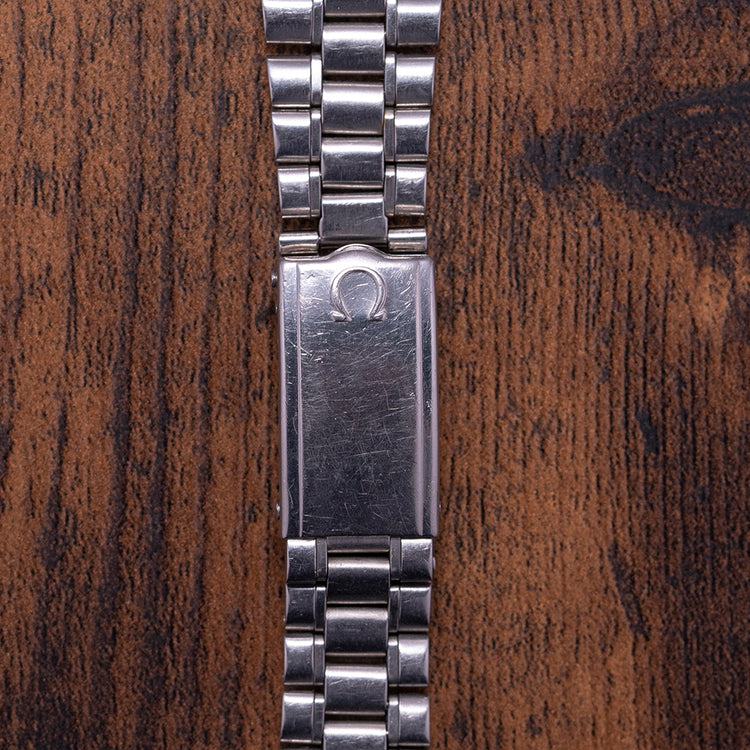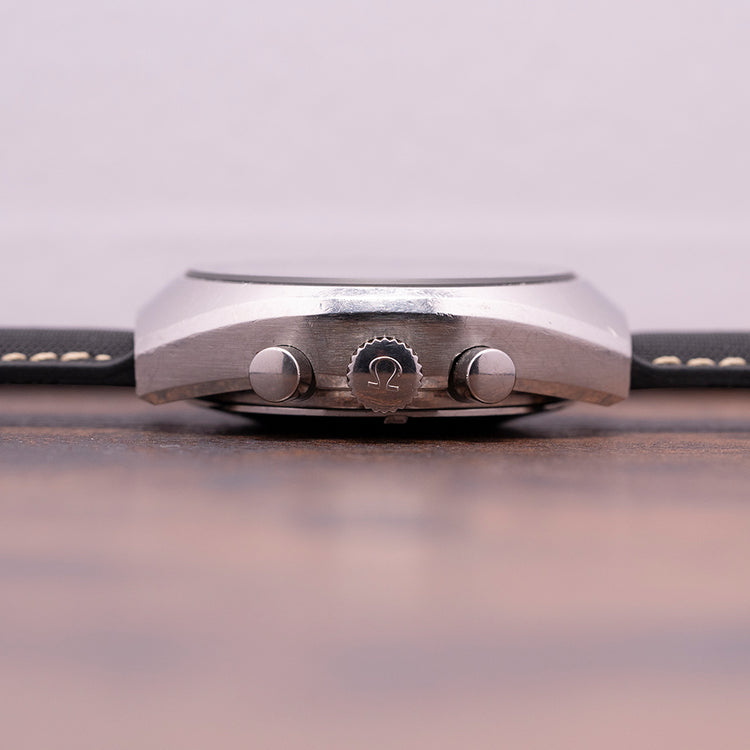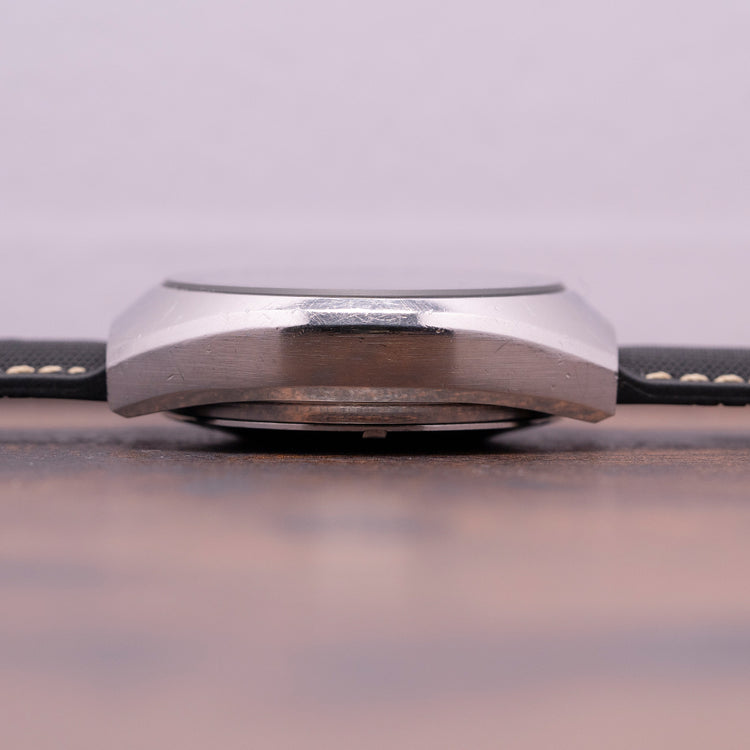More Information
Description
More
Less
The Watch
It was 1969 we had just had one of man's finest achievements with stepping on the moon, Omega felt they needed to design a watch that encapsulates the future, showcasing their commitment to a modernist innovative design, step forward to our 1970 Omega Speedmaster Professional Mark II 145.014 with a 41.5mm tonneau-shaped case, its lines between polished and brushed seamlessly transition, the sides have polished chamfered edges with a brushed centre and radially brushed top surface, making the case a much more dynamic case than you normally find on a Speedmaster. A lug-to-lug length of 45mm and a case thickness of 14mm give the watch an impressive wrist presence, down the right side, we have pushers and a signed crown, more flush with the case than on other models. The flowing lines continue as the case encircles the flat crystal without the need for a bezel, the matte black dial has a raised outer Tachymetre above the white second's track with baton indexes marking the hours coated in Tritium, at 3 o’clock a 30-minute register, at 6 o’clock 12-hour register and finally, a running 60 seconds register at 9 o’clock, each register is slightly recessed creating depth and interest to the dial. Slim white baton hands with Tritium infill complete with an arrow point chronograph seconds hand. On the reverse, we have a screw-down case back with an engraved Hippocampus in its centre, a seahorse that represents Neptune the God of the sea, it was conceived by Pierre Borie after seeing a picture of Neptune riding a chariot pulled by seahorses, it is the reason why the seahorses are wearing a bridle. Inside a manually wound Omega Cal. 861, 17 jewels based on the Lemania 1873 and is the direct Calibre replacement to the 361 Omega used on the moon. The watch comes paired with its 20mm original Omega bracelet with a signed folding clasp, the bracelet is full-sized and has never been sized, and the clasp spring bars are still sealed, an additional strap is provided.
Points of Mention
This watch is sold as "Watch Only" and therefore comes with no original Omega box or original Omega paperwork. The watch comes paired with its 20mm original Omega bracelet with a signed folding clasp, the bracelet is full-sized and has never been sized, and the clasp spring bars are still sealed, an additional strap is provided. The watch is from Circa. 1970 and is in worn condition with some marks as you would expect, the watch is all original and the dial and handset are in fantastic vintage condition with an even patina as you can see from the photographs. The watch comes with our 12-Months NON-Waterproof Warranty.
For more photos see here - https://drive.google.com/drive/folders/1Dj5Ft1uhIyysmBmfqfnCKqOUNQXQu25F?usp=share_link
Personal Note
As a massive fan of alternatively shaped watches, the MKII has always held a space in my heart. When this watch came to me from the original family this watch pulled on my heartstrings, the gentleman that used to own this worked around Clerkenwell Road so it made its way back to the area. As much as I wanted to keep this example it holds a story worth sharing for a first-to-market piece!
Specification
Lugs : 20mm
Condition : Pre-Owned
Box & Papers : None
Case Material : Stainless Steel
Warranty : 12-Months NON-Waterproof Warranty
The Brand
Formerly known as the La Generale Watch Co. in 1848 founded by Louis Brandt in La Chaux-de-Fonds. When he died in 1879, his sons carried on his dream. In 1880 they moved to 96 Rue Jakob-Stampfli where they remain today. The brothers produced their first mass-produced calibre, the Labrador In 1885. Just a few years later in 1892, they produced the first minute-repeater. In 1903 they renamed the company Omega until 1982 when they officially changed their name to Omega SA. During WW1 Omega watches were used as official timekeepers for the Royal Flying Corps and the US Army. In 1930, Omega and Tissot merged together to form Société Suisse pour l'Industrie Horlogère (SSIH) In 1931, another group was formed - Allgemeine Schweizerische Uhrenindustrie AG (ASUAG). Where SSIH was primarily French-speaking, ASUAG was founded by the more German-speaking members of the Swiss watch industry. In 1948 they introduced the first edition of one of its most symbolic watches: the Seamaster. Omega first introduced the Constellation in 1952. At the time it was Omega's flagship timepiece. The first models had a Cal. 354 bumper movement in them. Later in 1955, Omega introduced the Automatic Cal. 50x, followed in 1959 by the Cal.55x (no date) and 56x (date) versions. Many of the Constellations came with pie-pan dials, diamond indexes, and fancy lug configurations. All the gold Constellations of that time have the Observatory of Geneva's hand engraved on the back. The stainless steel and stainless steel/gold versions had a gold medallion on the back with the Observatory of Geneva. The eight stars above the Observatory stand for the many exploits of Omega in the world Chronometer competition. Celebrating the fact that all Constellations are Chronometer Certified. In 1962, when astronaut Wally Schirra wore a Speedmaster on his Mercury Sigma 7 Mission, making it the first Omega watch to enter space. After rigorous tests, NASA used Omega for all their Apollo missions including the 1969 Moon landing of Apollo 11. Today Omega is still an astronaut's first choice. In 1969, President Nixon famously said it was “too valuable” and turned down the first-ever all-gold Speedmaster Professional Deluxe. As a response to the ever-growing threat of electronic watches to the manufacturers of mechanical watches, Omega and many Swiss brands such as Rolex and Patek Philippe formed Centre Electronique Horologer (CEH). Prototypes began to appear in 1967 with their production starting in 1968. Then In 1972, Omega introduced the reference, 198.030, which included the Omega calibre 1250, a ‘tuning-fork electronic movement which was made under licence from Bulova. Later we saw a merger of SSIH and ASUAG into SMH, or Société de Microélectronique et d’Horlogerie. This merger took place in 1983. In 1992, the company acquired Blancpain, and in 1998 it officially rebranded itself from SMH to the Swatch Group. Then, in 1999, they purchased and integrated Breguet into the Swatch Group.
Points of Mention
More
Less
Personal Note
More
Less
Specification
More
Less
Movement : Manually Wound Omega Cal. 861
Year : 1970
Case Size : 40mm
Case Thickness : 14 mm
Lug to Lug : 45mm
Lugs : 20mm
Condition : Pre-Owned
Box and Papers : None
Case Material : Stainless Steel
Warranty : 12-Months NON-Waterproof Warranty
The wrist model's wrist size is 7inch
About Omega
More
Less
Description
The Watch
It was 1969 we had just had one of man's finest achievements with stepping on the moon, Omega felt they needed to design a watch that encapsulates the future, showcasing their commitment to a modernist innovative design, step forward to our 1970 Omega Speedmaster Professional Mark II 145.014 with a 41.5mm tonneau-shaped case, its lines between polished and brushed seamlessly transition, the sides have polished chamfered edges with a brushed centre and radially brushed top surface, making the case a much more dynamic case than you normally find on a Speedmaster. A lug-to-lug length of 45mm and a case thickness of 14mm give the watch an impressive wrist presence, down the right side, we have pushers and a signed crown, more flush with the case than on other models. The flowing lines continue as the case encircles the flat crystal without the need for a bezel, the matte black dial has a raised outer Tachymetre above the white second's track with baton indexes marking the hours coated in Tritium, at 3 o’clock a 30-minute register, at 6 o’clock 12-hour register and finally, a running 60 seconds register at 9 o’clock, each register is slightly recessed creating depth and interest to the dial. Slim white baton hands with Tritium infill complete with an arrow point chronograph seconds hand. On the reverse, we have a screw-down case back with an engraved Hippocampus in its centre, a seahorse that represents Neptune the God of the sea, it was conceived by Pierre Borie after seeing a picture of Neptune riding a chariot pulled by seahorses, it is the reason why the seahorses are wearing a bridle. Inside a manually wound Omega Cal. 861, 17 jewels based on the Lemania 1873 and is the direct Calibre replacement to the 361 Omega used on the moon. The watch comes paired with its 20mm original Omega bracelet with a signed folding clasp, the bracelet is full-sized and has never been sized, and the clasp spring bars are still sealed, an additional strap is provided.
Points of Mention
This watch is sold as "Watch Only" and therefore comes with no original Omega box or original Omega paperwork. The watch comes paired with its 20mm original Omega bracelet with a signed folding clasp, the bracelet is full-sized and has never been sized, and the clasp spring bars are still sealed, an additional strap is provided. The watch is from Circa. 1970 and is in worn condition with some marks as you would expect, the watch is all original and the dial and handset are in fantastic vintage condition with an even patina as you can see from the photographs. The watch comes with our 12-Months NON-Waterproof Warranty.
For more photos see here - https://drive.google.com/drive/folders/1Dj5Ft1uhIyysmBmfqfnCKqOUNQXQu25F?usp=share_link
Personal Note
As a massive fan of alternatively shaped watches, the MKII has always held a space in my heart. When this watch came to me from the original family this watch pulled on my heartstrings, the gentleman that used to own this worked around Clerkenwell Road so it made its way back to the area. As much as I wanted to keep this example it holds a story worth sharing for a first-to-market piece!
Specification
Lugs : 20mm
Condition : Pre-Owned
Box & Papers : None
Case Material : Stainless Steel
Warranty : 12-Months NON-Waterproof Warranty
The Brand
Formerly known as the La Generale Watch Co. in 1848 founded by Louis Brandt in La Chaux-de-Fonds. When he died in 1879, his sons carried on his dream. In 1880 they moved to 96 Rue Jakob-Stampfli where they remain today. The brothers produced their first mass-produced calibre, the Labrador In 1885. Just a few years later in 1892, they produced the first minute-repeater. In 1903 they renamed the company Omega until 1982 when they officially changed their name to Omega SA. During WW1 Omega watches were used as official timekeepers for the Royal Flying Corps and the US Army. In 1930, Omega and Tissot merged together to form Société Suisse pour l'Industrie Horlogère (SSIH) In 1931, another group was formed - Allgemeine Schweizerische Uhrenindustrie AG (ASUAG). Where SSIH was primarily French-speaking, ASUAG was founded by the more German-speaking members of the Swiss watch industry. In 1948 they introduced the first edition of one of its most symbolic watches: the Seamaster. Omega first introduced the Constellation in 1952. At the time it was Omega's flagship timepiece. The first models had a Cal. 354 bumper movement in them. Later in 1955, Omega introduced the Automatic Cal. 50x, followed in 1959 by the Cal.55x (no date) and 56x (date) versions. Many of the Constellations came with pie-pan dials, diamond indexes, and fancy lug configurations. All the gold Constellations of that time have the Observatory of Geneva's hand engraved on the back. The stainless steel and stainless steel/gold versions had a gold medallion on the back with the Observatory of Geneva. The eight stars above the Observatory stand for the many exploits of Omega in the world Chronometer competition. Celebrating the fact that all Constellations are Chronometer Certified. In 1962, when astronaut Wally Schirra wore a Speedmaster on his Mercury Sigma 7 Mission, making it the first Omega watch to enter space. After rigorous tests, NASA used Omega for all their Apollo missions including the 1969 Moon landing of Apollo 11. Today Omega is still an astronaut's first choice. In 1969, President Nixon famously said it was “too valuable” and turned down the first-ever all-gold Speedmaster Professional Deluxe. As a response to the ever-growing threat of electronic watches to the manufacturers of mechanical watches, Omega and many Swiss brands such as Rolex and Patek Philippe formed Centre Electronique Horologer (CEH). Prototypes began to appear in 1967 with their production starting in 1968. Then In 1972, Omega introduced the reference, 198.030, which included the Omega calibre 1250, a ‘tuning-fork electronic movement which was made under licence from Bulova. Later we saw a merger of SSIH and ASUAG into SMH, or Société de Microélectronique et d’Horlogerie. This merger took place in 1983. In 1992, the company acquired Blancpain, and in 1998 it officially rebranded itself from SMH to the Swatch Group. Then, in 1999, they purchased and integrated Breguet into the Swatch Group.
Points of Mention
Personal Note
Specification
The Brand
Enquire or Book an Appointment
Would you like to discover further details about this watch, or perhaps arrange an appointment to view and try it on? Complete this form and a member of our team will get back to you shortly.
You May Also Like




















